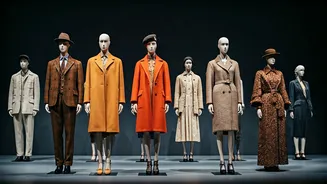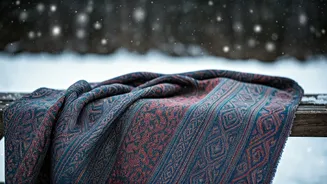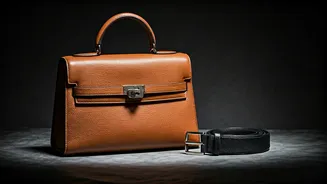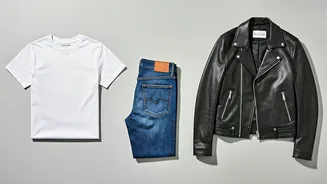Historical Foundations
Fashion's history is as diverse as the styles themselves. For centuries, clothing served primarily as protection against the elements, with practicality
taking precedence. Styles varied significantly based on geographic locations and the availability of resources. Royalty and the wealthy played a key role in setting trends. The intricate designs, luxurious fabrics, and status symbols, like extravagant hats and ornate jewelry, signaled wealth and power. Over time, as trade expanded, different cultures began to influence each other's clothing. This exchange of ideas and materials eventually laid the groundwork for the global fashion industry we know today. The Renaissance saw a surge in artistic and sartorial expression, with elaborate garments reflecting the era's focus on beauty and refinement, a contrast to earlier, more functional designs.
The Roaring Twenties
The 1920s brought about a significant shift in fashion, marking a time of cultural change and rebellion. The flapper style, with its shorter hemlines, loose silhouettes, and beaded embellishments, challenged the conservative norms of previous decades. It represented a desire for freedom and liberation, especially for women. The introduction of mass production and affordable fabrics made fashion more accessible to a broader audience, fostering the rise of ready-to-wear clothing. Iconic designers like Coco Chanel emerged during this period, leaving an undeniable impact. Chanel’s designs promoted comfort and functionality, rejecting the restrictive styles of the past. The era also witnessed the growing popularity of sportswear and more casual attire, reflecting a shift in lifestyle and a desire for greater mobility and ease.
Post-War Chic
Following World War II, fashion experienced a period of renewal and optimism. Christian Dior's 'New Look' revolutionized the industry with its cinched waists, full skirts, and elegant silhouettes. This contrasted sharply with the wartime restrictions and rationing. The New Look represented a return to femininity and luxury, sparking a demand for more elaborate and glamorous clothing. The 1950s also saw the rise of youth culture, which greatly influenced fashion. Teenagers began to express their individuality through their clothing choices, leading to the emergence of subcultures like the greasers and the beatniks, each adopting distinct styles. Hollywood's influence became increasingly significant, with movie stars becoming style icons and driving trends. From elegant dresses to casual wear, the post-war era set the stage for further evolution.
The Swinging Sixties
The 1960s were a time of major social and cultural transformation, influencing fashion in remarkable ways. The decade brought forth the miniskirt, a bold statement of youth and liberation. Designers like Mary Quant spearheaded this trend, which rapidly gained popularity. The era championed bold colors, geometric patterns, and futuristic designs, reflecting the optimism and excitement of the space age. The rise of pop art and the influence of music, particularly the British Invasion, significantly impacted fashion. Mod style, with its clean lines, bold graphics, and close-fitting silhouettes, became a defining look. This era saw the introduction of unisex clothing, reflecting changing attitudes toward gender roles. The 1960s were a period of innovation and experimentation, pushing the boundaries of what was considered acceptable.
Seventies Style
The 1970s brought forth a diverse range of styles. The bohemian look, with flowing dresses, bell-bottoms, and earthy tones, became a major trend, often reflecting a countercultural ethos. Disco fashion, with its sparkly fabrics, platform shoes, and flamboyant styles, captured the energy of the dance floor. Punk fashion also emerged, challenging conventional norms with its ripped clothing, safety pins, and rebellious attitude. The decade also saw the rise of sportswear and casual wear, with tracksuits, jeans, and t-shirts gaining popularity. Designers like Diane von Furstenberg, known for her wrap dress, significantly impacted the era. High-waisted pants and platform boots further characterized the decade. The 1970s was a mix of different influences, reflecting the evolving cultural and social landscape.
Eighties Excess
The 1980s were synonymous with bold and flamboyant fashion choices. Power dressing became a prominent trend, with strong shoulder pads, tailored suits, and a focus on expressing success. This style reflected the era's focus on ambition and corporate culture. Bright colors, neon hues, and loud patterns were everywhere. Fitness culture also had a significant influence. Leggings, leotards, and athletic-inspired clothing became part of everyday wear. Music and MTV also played a significant role, with artists influencing fashion trends. The rise of streetwear and hip-hop culture introduced new styles, including tracksuits, sneakers, and oversized clothing. The 1980s were an era of excess, experimentation, and individuality, pushing the boundaries of fashion.
Nineties Minimalism
The 1990s witnessed a shift toward minimalism and grunge. The minimalist trend embraced simple silhouettes, neutral colors, and a focus on quality fabrics. This was a response to the extravagance of the 1980s. Grunge fashion, with its ripped jeans, oversized flannels, and combat boots, reflected a rejection of mainstream values and a focus on authenticity. The influence of hip-hop culture continued to grow, shaping trends like baggy jeans, crop tops, and streetwear. Designers like Calvin Klein and Donna Karan gained prominence during this era. The rise of the supermodel phenomenon also played a significant role, with models becoming celebrities in their own right. The 1990s marked a return to a more understated aesthetic, reflecting changing cultural and social values.
The 21st Century
The 21st century has been defined by the rise of technology, globalization, and social media, which transformed the way fashion is created, distributed, and consumed. The internet and social media platforms gave rise to online shopping and fast fashion, making trends more accessible than ever. The influence of celebrities and influencers on fashion grew significantly. Sustainability and ethical considerations gained prominence, with increasing focus on environmental impact and fair labor practices. The industry saw a greater emphasis on diversity and inclusivity, with brands and designers striving to represent a wider range of people. The trend of mixing high-end designer pieces with more affordable, accessible options has gained popularity, leading to unique and diverse expressions of fashion.
The Future of Style
Looking forward, the future of fashion will probably be shaped by technological advancements. 3D printing, artificial intelligence, and virtual reality could transform design and production processes. Sustainability will remain a key driver, with innovative materials and circular economy models gaining more importance. Personalization and customization will likely grow, with consumers seeking unique, individual expression. The fusion of fashion and technology, such as wearable technology and smart clothing, will offer new possibilities. Collaboration and inclusivity will continue to be important, with a greater emphasis on diversity and ethical practices. The future of fashion promises to be innovative, sustainable, and personalized, reflecting the evolving values and priorities of society.











